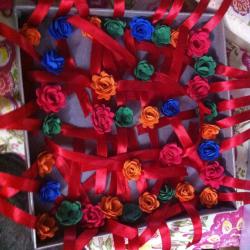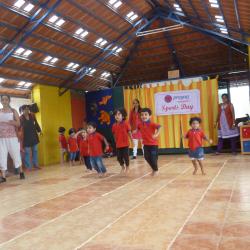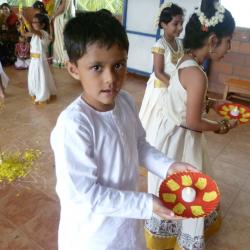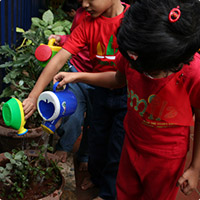 The child is introduced initially with practical life as he/she is familiar with most of the materials at home but has not laid his hands over them. This attracts them to these activities that give them independence and control of their own life. This basically helps him to take care of himself, take care of his environment, helps him with his/her eye-hand co-ordination, and with his/her social behavior. The most important need of the young child is to develop his muscles and co-ordinate his movement through such practical life exercises as sweeping, polishing, carrying water, pouring and wiping a table. Special Montessori materials enable him to tie, button, snap and use many other fastening devices.
The child is introduced initially with practical life as he/she is familiar with most of the materials at home but has not laid his hands over them. This attracts them to these activities that give them independence and control of their own life. This basically helps him to take care of himself, take care of his environment, helps him with his/her eye-hand co-ordination, and with his/her social behavior. The most important need of the young child is to develop his muscles and co-ordinate his movement through such practical life exercises as sweeping, polishing, carrying water, pouring and wiping a table. Special Montessori materials enable him to tie, button, snap and use many other fastening devices.
The purpose of these exercises is to develop concentration, and to pay attention to detail as the child follows a regular sequence of actions and to learn good working habits. These activities provide the very foundation on which the child approaches more intricate academic exercises.


 One aspect of the Montessori Method taught at all Montessori schools is the Sensorial exercises. Sensorial Materials in the Montessori environment are designed to sharpen the senses of the young child and enable the child to understand the many impressions he receives through them. Each of the Sensorial Materials isolates one defining quality such as color, weight, shape, texture, size, sound or smell. The Montessori Sensorial Materials help the child to distinguish, to categorize, and to relate new information to what he already knows.
One aspect of the Montessori Method taught at all Montessori schools is the Sensorial exercises. Sensorial Materials in the Montessori environment are designed to sharpen the senses of the young child and enable the child to understand the many impressions he receives through them. Each of the Sensorial Materials isolates one defining quality such as color, weight, shape, texture, size, sound or smell. The Montessori Sensorial Materials help the child to distinguish, to categorize, and to relate new information to what he already knows.  The child learns oral language naturally. He automatically absorbs it from his environment. When the child enters a Montessori environment he/she learns that the words are made of sounds and each sound has a symbol. By absorbing the sounds and the symbols, the Montessori child begins reading when he is ready and proceeds at his own pace. His experiences in practical life and sensorial education serve as a preparation for his writing.
The child learns oral language naturally. He automatically absorbs it from his environment. When the child enters a Montessori environment he/she learns that the words are made of sounds and each sound has a symbol. By absorbing the sounds and the symbols, the Montessori child begins reading when he is ready and proceeds at his own pace. His experiences in practical life and sensorial education serve as a preparation for his writing. The materials for Arithmetic introduce the child to associate quantity and its symbols i.e., the numbers 0 through 9. The quantities are introduced by a series of rods, which the child can count. Then he/she matches the sets of symbol cards with the rods. Using a wide range of beads and symbol cards, the child becomes familiar with the numbers as a decimal system, including concrete experiences with the operations of addition, subtraction, multiplication and division. These exercises not only teach the child to calculate, but they provide a deep understanding how numbers function and the relation between the quantity and symbol.
The materials for Arithmetic introduce the child to associate quantity and its symbols i.e., the numbers 0 through 9. The quantities are introduced by a series of rods, which the child can count. Then he/she matches the sets of symbol cards with the rods. Using a wide range of beads and symbol cards, the child becomes familiar with the numbers as a decimal system, including concrete experiences with the operations of addition, subtraction, multiplication and division. These exercises not only teach the child to calculate, but they provide a deep understanding how numbers function and the relation between the quantity and symbol.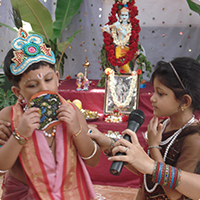 Culture plays a very active role in the Pre-primary Montessori Environment. Children are offered culture in the form of festivals and celebrations conducted through-out the year. Geography and Botany too, as being part of our outer environment, become integral in our process to offer culture to the children. Geography starts with introduction to water and land bodies, progressing to the study of the earth in the form of a globe/map. Children get to learn more about different continents and explore India in general through photographs, moulds and geography puzzles.
Culture plays a very active role in the Pre-primary Montessori Environment. Children are offered culture in the form of festivals and celebrations conducted through-out the year. Geography and Botany too, as being part of our outer environment, become integral in our process to offer culture to the children. Geography starts with introduction to water and land bodies, progressing to the study of the earth in the form of a globe/map. Children get to learn more about different continents and explore India in general through photographs, moulds and geography puzzles.